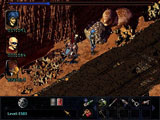 When I was six years old, Thanksgiving
became the ultimate holiday because of turkey. Having
never seen one, I could only go by what my mother said, and she made it sound grand. Anything saved for one day of the year had to be
special. I ran around the house shouting,
“We’re going to have turkey. Turkey. Who’s having turkey? Us. TUUUURRRKKEEEYYY!” When dinner approached, mom led me to the kitchen,
opened the oven a peep and told me to look inside. Fighting
through the steam, I stared in, saw the pale flesh of the beast and asked, “What is
that?” When I was six years old, Thanksgiving
became the ultimate holiday because of turkey. Having
never seen one, I could only go by what my mother said, and she made it sound grand. Anything saved for one day of the year had to be
special. I ran around the house shouting,
“We’re going to have turkey. Turkey. Who’s having turkey? Us. TUUUURRRKKEEEYYY!” When dinner approached, mom led me to the kitchen,
opened the oven a peep and told me to look inside. Fighting
through the steam, I stared in, saw the pale flesh of the beast and asked, “What is
that?”
“Turkey,” mom said.
“Well I don’t want any,” I responded.
Thanksgiving has since been a time of ruined expectations, and this season the same
pattern played out with Septerra Core by Monolith. I
really wanted to like this game. There has
been a buzz surrounding its release, and I anticipated big things. I wanted an RPG with such a fantastic setting and
game play that I’d look up from Baldur’s Gate, forget about Fallout 2, and stop
biting my nails in anticipation for Torment. 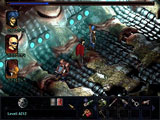 Septerra Core
starts auspiciously with a fantastic and informative intro movie – something many
games either ignore completely or treat as eye-candy/filler. The world of Speterra Core is composed of seven
floating continents, circling one above the other around a bio-computer core. Wheeeee, I’m hooked. Let’s have more. But after this
intriguing landscape, the story line unfolds along predictable lines: there’s good,
there’s evil, an artifact everybody wants, and snooty, rich, technologically advanced
guys called The Chosen. You play Maya, a
squatter on the shell beneath The Chosen and living off their refuse. It’s a rags-to-riches story and Horatio Alger
can go eat dirt. While the story is a bit
unimaginative, it had enough of a plot, coupled with a great setting, to carry me through
the beginning of the game. Septerra Core
starts auspiciously with a fantastic and informative intro movie – something many
games either ignore completely or treat as eye-candy/filler. The world of Speterra Core is composed of seven
floating continents, circling one above the other around a bio-computer core. Wheeeee, I’m hooked. Let’s have more. But after this
intriguing landscape, the story line unfolds along predictable lines: there’s good,
there’s evil, an artifact everybody wants, and snooty, rich, technologically advanced
guys called The Chosen. You play Maya, a
squatter on the shell beneath The Chosen and living off their refuse. It’s a rags-to-riches story and Horatio Alger
can go eat dirt. While the story is a bit
unimaginative, it had enough of a plot, coupled with a great setting, to carry me through
the beginning of the game.
Fantastic hand-painted graphics
and voice acting further bolstered my initial impression.
Like most games I’ve reviewed lately, there was no ambient sound to speak of,
but the long cut scenes are superb and entertaining.
In fact, it is those cut scenes that stand out as the best part of the game:
appearing at appropriate intervals – never stumbling over each other, but frequent
enough to keep interest in the narrative alive – and with such excellent anime style
graphics that they were a joy to watch. In
the first few hours of gaming, Septerra Core stood out, and I wanted the rest of it to be
as good.
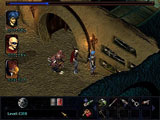 Septerra Core bills
itself as an RPG. It isn’t exactly. RPG’s distinguish themselves from other games
by allowing the player a degree of choice in the development of character through
generation or skills. In Septerra Core, you are forced to play Maya
and, while you gain levels of experience, you have no choice as to how her abilities
progress. The player is given a role instead
of creating one. In computer RPGs, as opposed to console RPGs, it just
isn’t enough to embody a character that accumulates experience points, and I don't
think Septerra Core has enough role-playing elements to deserve the name. Septerra Core bills
itself as an RPG. It isn’t exactly. RPG’s distinguish themselves from other games
by allowing the player a degree of choice in the development of character through
generation or skills. In Septerra Core, you are forced to play Maya
and, while you gain levels of experience, you have no choice as to how her abilities
progress. The player is given a role instead
of creating one. In computer RPGs, as opposed to console RPGs, it just
isn’t enough to embody a character that accumulates experience points, and I don't
think Septerra Core has enough role-playing elements to deserve the name.
As in other areas, gameplay is
initially interesting. The camera is fixed
third person oblique (a l� Balder’s Gate) with two levels of map view: a large map
with hotspots that transport play to smaller, interactive maps. You scamper about accompanied by a few boon
companions whose stuff you can mess with and who will squabble if they don’t like
each other. A good portion of time is spent
talking with villagers, each with their own argot and personality ticks. When speaking, you are giving a preset list of
possible topics, and, while it was simple to get information by selecting every possible
topic, the other members of your party can ask questions as well. (One character, a sort of robo-dog named Runner,
barks at everybody.) I had a lot of fun
during these portions, and Septerra Core’s exploratory elements pleased me a great
deal.
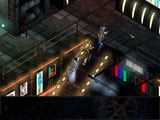 Everything looks okay until you get
into a fight. When you come upon a bad guy,
the game switches to a clock-based scheme in which actions – attacking, casting
spells, utilizing inventory equipment – depend on the accumulation of endurance. In other words, you wait. After so much time, you can do something. Battles are static and uncompelling. Characters don’t get to move around, find
advantageous positions or use strategy of any kind. They
hit you. You hit them. I thought the first battle was a joke. That it couldn’t be this boring. The bad guys appear in the same positions no
matter how many times you kill them, and since you have to return to areas several times,
imagine the fun of the same battle over and over. Everything looks okay until you get
into a fight. When you come upon a bad guy,
the game switches to a clock-based scheme in which actions – attacking, casting
spells, utilizing inventory equipment – depend on the accumulation of endurance. In other words, you wait. After so much time, you can do something. Battles are static and uncompelling. Characters don’t get to move around, find
advantageous positions or use strategy of any kind. They
hit you. You hit them. I thought the first battle was a joke. That it couldn’t be this boring. The bad guys appear in the same positions no
matter how many times you kill them, and since you have to return to areas several times,
imagine the fun of the same battle over and over.
The magic component, casting
spells via Fate Cards that are found as play progresses, had lots of possibilities
because, rather than individual magic ability, the group’s mana is pooled. Anybody can cast any spell. Cards could be also combined in novel ways to
produce different effects. Unfortunately,
this system is wasted in combat. Again, the
player just waits and whatever potential existed evaporates in the face of an annoying
combat interface. Septerra Core is combat
heavy and the amount of time spent getting physical overwhelms portions of the game that
worked well.
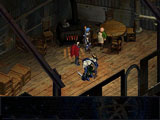 What you end up with is a console game
on the computer. If you’re a fan of the
Final Fantasy series, this might be familiar, but I don’t want to be unfair to
console systems, which work in a different milieu and under different restrictions. My impression is that the narrative is supposed
to pull the Septerra Core together and it doesn’t.
A good plot doesn’t compensate for a poor design, and no matter how
fascinating the next narratological twist, I had to fight to keep playing. What you end up with is a console game
on the computer. If you’re a fan of the
Final Fantasy series, this might be familiar, but I don’t want to be unfair to
console systems, which work in a different milieu and under different restrictions. My impression is that the narrative is supposed
to pull the Septerra Core together and it doesn’t.
A good plot doesn’t compensate for a poor design, and no matter how
fascinating the next narratological twist, I had to fight to keep playing.
For Thanksgiving you will want a
good diversion between rounds of mashed potatoes, football, and bizarre, rarely-seen
relatives. There are a few things – like
setting, graphics and acting sequences – that give Septerra Core promise, and, if
there were a significant role-playing component, I could dismiss the console-on-the-PC
style play. If there were a good combat
system, I could recommend it in spite of the role-playing irregularities. Before you scramble through the house getting
riled up and sweaty, listen: I’ve looked in the oven, seen the animal, and, trust me,
Septerra Core just doesn't live up to expectations.
--Matt Blackburn |

 When I was six years old, Thanksgiving
became the ultimate holiday because of turkey. Having
never seen one, I could only go by what my mother said, and she made it sound grand. Anything saved for one day of the year had to be
special. I ran around the house shouting,
“We’re going to have turkey. Turkey. Who’s having turkey? Us. TUUUURRRKKEEEYYY!” When dinner approached, mom led me to the kitchen,
opened the oven a peep and told me to look inside. Fighting
through the steam, I stared in, saw the pale flesh of the beast and asked, “What is
that?”
When I was six years old, Thanksgiving
became the ultimate holiday because of turkey. Having
never seen one, I could only go by what my mother said, and she made it sound grand. Anything saved for one day of the year had to be
special. I ran around the house shouting,
“We’re going to have turkey. Turkey. Who’s having turkey? Us. TUUUURRRKKEEEYYY!” When dinner approached, mom led me to the kitchen,
opened the oven a peep and told me to look inside. Fighting
through the steam, I stared in, saw the pale flesh of the beast and asked, “What is
that?”